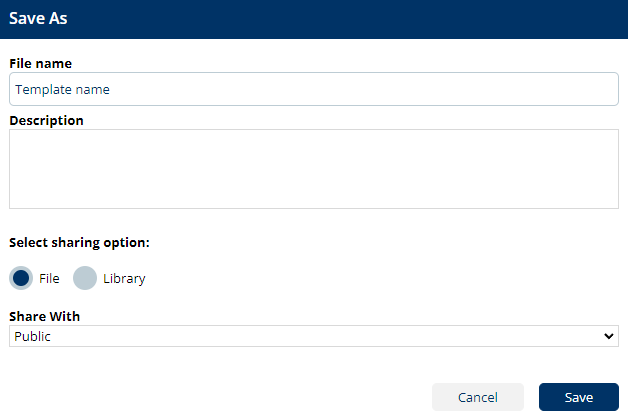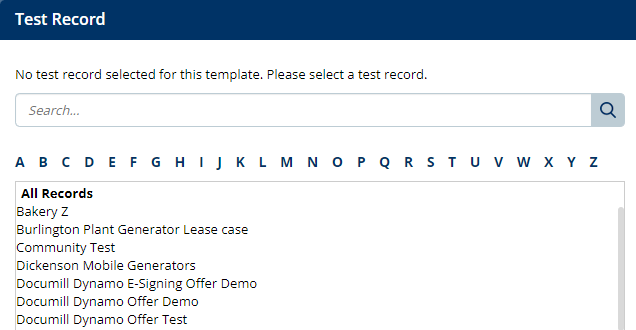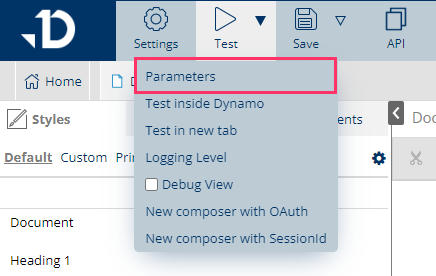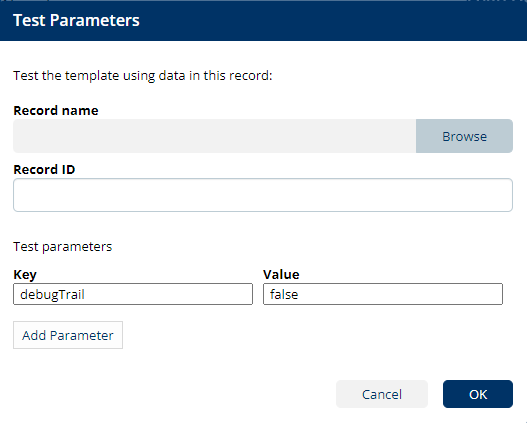Finishing with Creating a Template
After the template building process is finished, a few steps need to be taken to ensure the template will be available and working as intended for the Salesforce users. The template builder can also be used to debug template issues in greater detail by using debug view.
Saving a Template
It is recommended to occasionally save the template to ensure the progress is not lost.
Within the template builder, click on the Save button.

Clicking on the arrow next to the save icon will reveal more options.

From this menu, the template can be either saved or exported.
The Save button is used if the template file already exists within Salesforce, and the current template should be saved as a new version.
The Save As button is used to save the current template as a new file rather than as a new version of the existing template.
The Save to Cache button is used to save the current template to template cache. When template cache is in use, template loads much faster compared to loading template every time from Salesforce. Please note that if template is updated, it must be updated also to template cache. Template update can also be done from “Save -> Save to Cache” dialog.
The Export button allows users to download the template as a single file. This is useful if the Dynamo support team asks to be provided with a template file, there is a need to transfer the template to a different environment, or simply as a backup.
When saving a new template or using the Save As button, a dialog window will open. Here, the File name, description and saving location can be selected.

Testing a template
You can test the output document and end-user's experience on the spot when building the template with the Dynamo real-time testing function.
To test the template without saving any changes or going to Salesforce, click the Test icon in the Template Builder.
Make sure that you allow popups for Documill Dynamo server in the browser.

If testing for the first time, a window will appear asking for a testing record to be selected.

Search for a record which has the required testing data and select it.
Another window will open to run the template, using data from the Test Record. The test will replicate end-users' experience in Salesforce. If you have allowed end-users to select attachment, save file, change file name or email the output document, etc., you can test the whole journey. The document will also be saved into the Test Record in Files & Attachments in Salesforce.
If testing needs to be done on multiple records, the record can be changed by click on the arrow next to the Test button and selecting Parameters.

This will open a new window allowing the selection of a new record, either by searching its name or entering the record ID.

In the Test parameters section, parameters can be added, which can then be accessed as variable in the Main Flow from the param collection. E.g. ${param.debugTrail}. These parameters can only be used when testing from within the template builder.
If nothing happens after saving the test record or clicking on the Test button, check if the popup blocker is running in the browser. Allow pop-up to Documill Dynamo server and run the test again.
If the result document does not have the desired content, make sure that all the data stored in the Test Record properly. Also test with multiple Test Records to revise how the document looks like in different scenarios.
Debugging a Template
If any problems occur during testing, either an error message, the template does not look as expected or the data is not showing correctly, consult this article for more in-detail information about template debugging.
